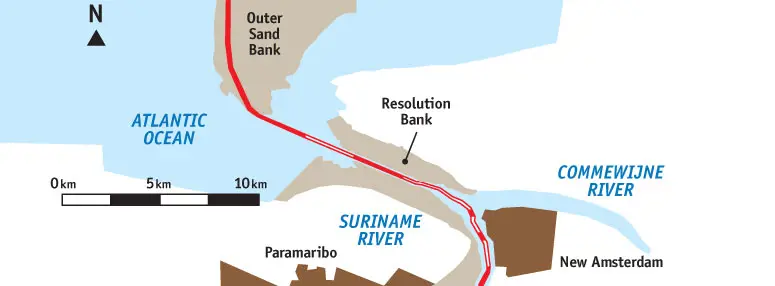The Maritime Authority Suriname (MAS) and the project financing consortium (BMS, Suralco, Staatsoile) commissioned SRK Consulting (UK) Ltd to conduct an Environmental and Social Impact Assessment (ESIA) for dredging the Suriname River in South America.
The project area covered a 90km stretch of the lower section of the Suriname River estuary that acts as a major transport link for connecting the industrial centres of Paranam and Paramaribo with the Atlantic Ocean. The capital, Paramaribo is home to approximately 50% of Suriname’s population.
The aim of the project was to undertake a capital dredging program to last approximately 9-12 months and remove 10 – 11Mm3 of sediment. It was designed to alter the existing navigation channel and create a larger, more-defined channel to allow an increase in the operational draught of vessels and increase the cargo efficiency (imports and exports) from Suriname. Over a period of 10 years, the project also involved a maintenance dredging program and ocean and in-river disposal of sediments, including the creation of a habitat island in the mouth of the river.
Planning for the Suriname River Dredging Project was carried out in line with Suriname legislation and international standards and guidelines, such as the Equator Principles, International Finance Corporation (IFC) Performance Standards and IFC Environmental Health and Safety (EHS) Guidelines. Other international guidelines specific to dredging, such the Australian National Ocean Disposal Guidelines (ANODG) for Dredged Material (2002), were considered, along with the corporate standards of BHP Billiton.
The biophysical and socio-economic baseline studies, as well as key stakeholder consultations, demonstrated that the Suriname River is a very perse and biologically-rich aquatic environment with great importance both for the functioning of the natural environment and the sustainability of the economic livelihood of local inhabitants. The project presented many challenges and potential impacts with the main ones being:
• Changes to the aquatic environment caused by disturbance to fish habitats from the removal, suspension and settling of sediments due to capital dredging and disposal operations
• Effects on fishermen livelihoods due to their restricted access to fishing grounds during dredging, and changes in the fish species and populations, resulting in a reduction in fish catches and income
• The potential impacts to the emerging eco-tourism industry in Suriname from the disturbance of aquatic species that were of conservation significance, such as the river dolphins and sea turtles
Due to the importance of the river to residents of Paramaribo, there was significant interest in the project from a perse range of industries, such as shipping, fishing (large and small scale), tourism, oil and mining, as well as the environmental protection agency (NIMOS) and riverside residents. As a result, significant consultation was undertaken with key stakeholders and the public to explain the project and consider the views of the government, industry and the community.
Generally, the project was well received and supported by interested parties as the benefits to the economy in terms of trade were quite significant for the country. One of the main issues centred on paying compensation to Project Affected People (PAP), primarily fishermen, who were likely to have their incomes and livelihoods affected or lost.
The Surinamese Government considered the project and it appeared likely to receive approval. Unfortunately, the decision by BHP Billiton to cease mining operations in Suriname has meant that the main financier and beneficiary of the project no longer has a vested interest in dredging the Suriname River and, therefore, the project is currently no longer under consideration.

